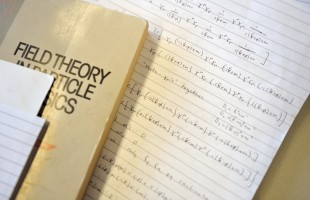The observation of a nuclear process called neutrinoless double-beta decay might help researchers figure out what gives neutrinos their mass and why there’s far more matter than antimatter in the Universe. Nikhef researcher Jordy de Vries collaborated with colleagues from Los Alamos to find out why this theoretical decay has not been observed.
The observation of a nuclear process called neutrinoless double-beta decay might help researchers figure out what gives neutrinos their mass and why there’s far more matter than antimatter in the Universe. While this hypothetical decay has never been observed, experiments have placed constraints on the maximum rate at which it could occur. Now Vincenzo Cirigliano of Los Alamos National Laboratory, New Mexico, and colleagues show that previous calculations of neutrinoless double-beta decay might have neglected a contribution that is critical for interpreting experimental data.
In ordinary double-beta decay, two neutrons become two protons, emitting two electrons and two electron antineutrinos. But some models indicate that neutrinos may be their own antiparticles. In that case, the two antineutrinos could cancel each other, and some decays wouldn’t emit any neutrinos. Experiments searching for this neutrinoless decay in a variety of isotopes have limited the decay’s half-life to be larger than 1025 years. These half-life limits, in turn, can be used to derive information on neutrino masses. That derivation, however, depends on the calculated amplitudes of the transitions between the nuclear states involved in the decay.
Cirigliano and collaborators show that reliable amplitude calculations must include a contribution due to interactions acting on short ranges (less than 1 femtometer). Previous studies had only included longer-range contributions acting on scales up to a few femtometers. The short-range contribution generates a transition amplitude that might be as large as the one calculated based on the long-range component only. The short- and long-range components could add up to make the neutrinoless decay more likely, or they could partly cancel out to make it less likely. More work is needed to determine the sign and magnitude of the short-range component. The authors’ preliminary estimates, however, indicate that it could significantly affect the neutrino mass properties derived from double-beta-decay experiments.
More information
This research is published in Physical Review Letters on 16 May 2018: Phys. Rev. Lett. 120, 202001 (2018)
Text: Christopher Crockett, Physics
Infographic: J. de Vries/Nikhef; adapted by APS/Alan Stonebraker
Source: This is an synopsis written for the website Physics. Physics provides news and commentary about papers from the Physical Review journals. Christopher Crockett is a freelance writer.

